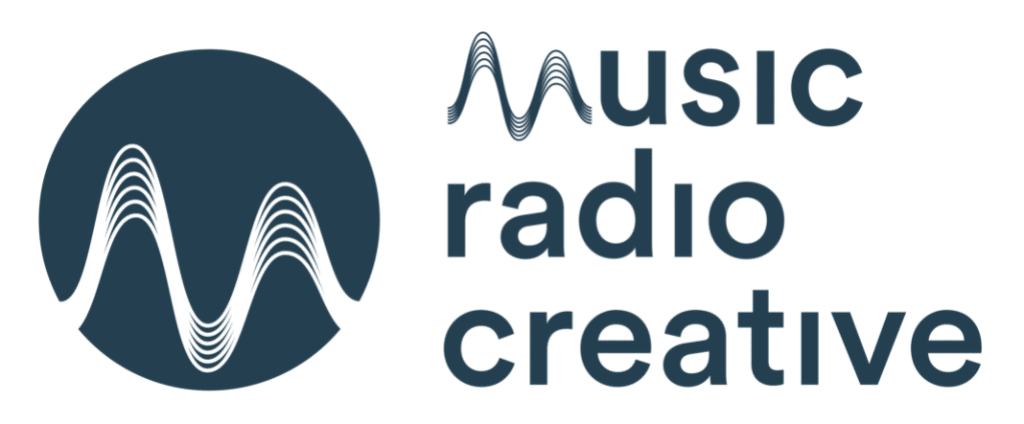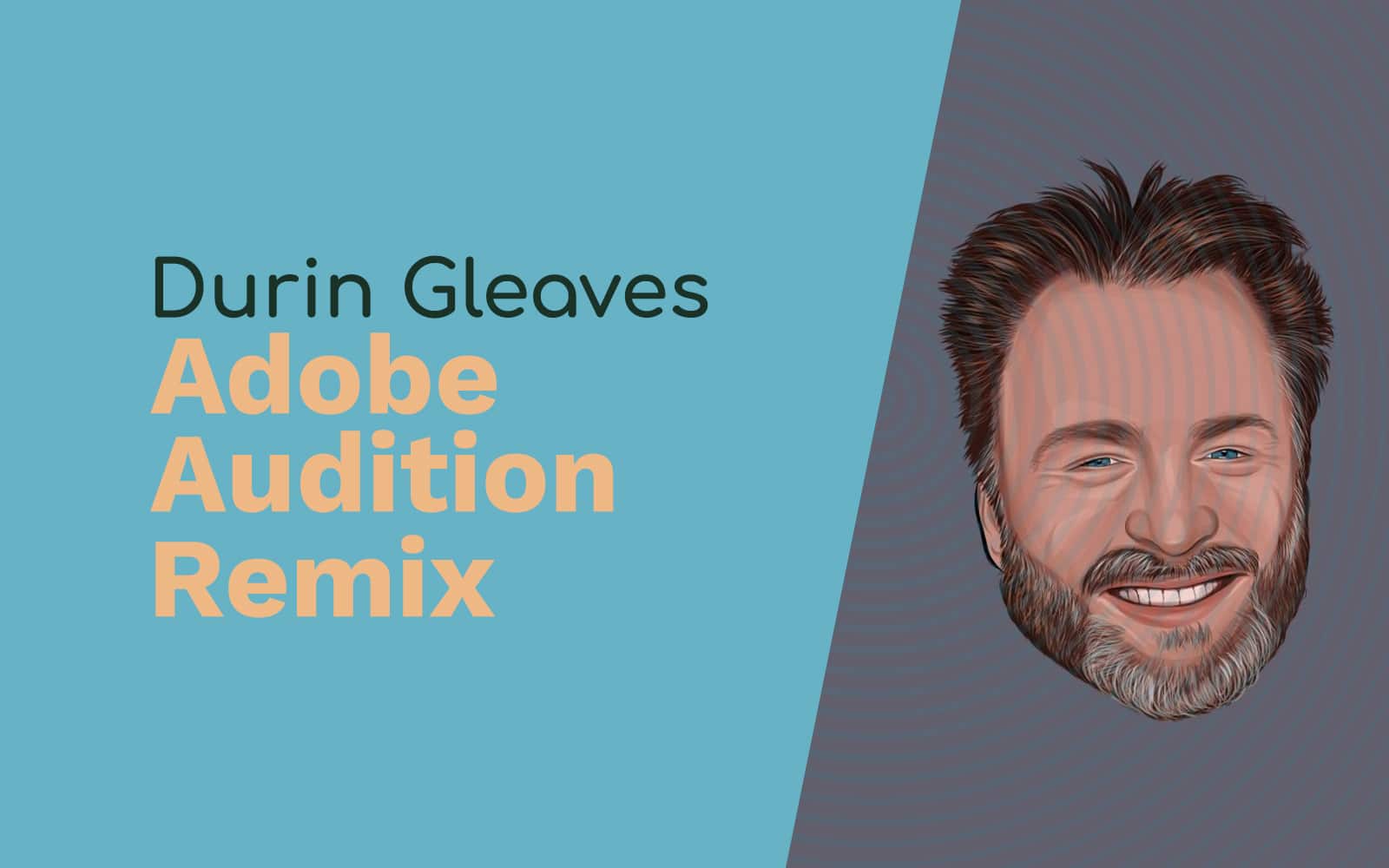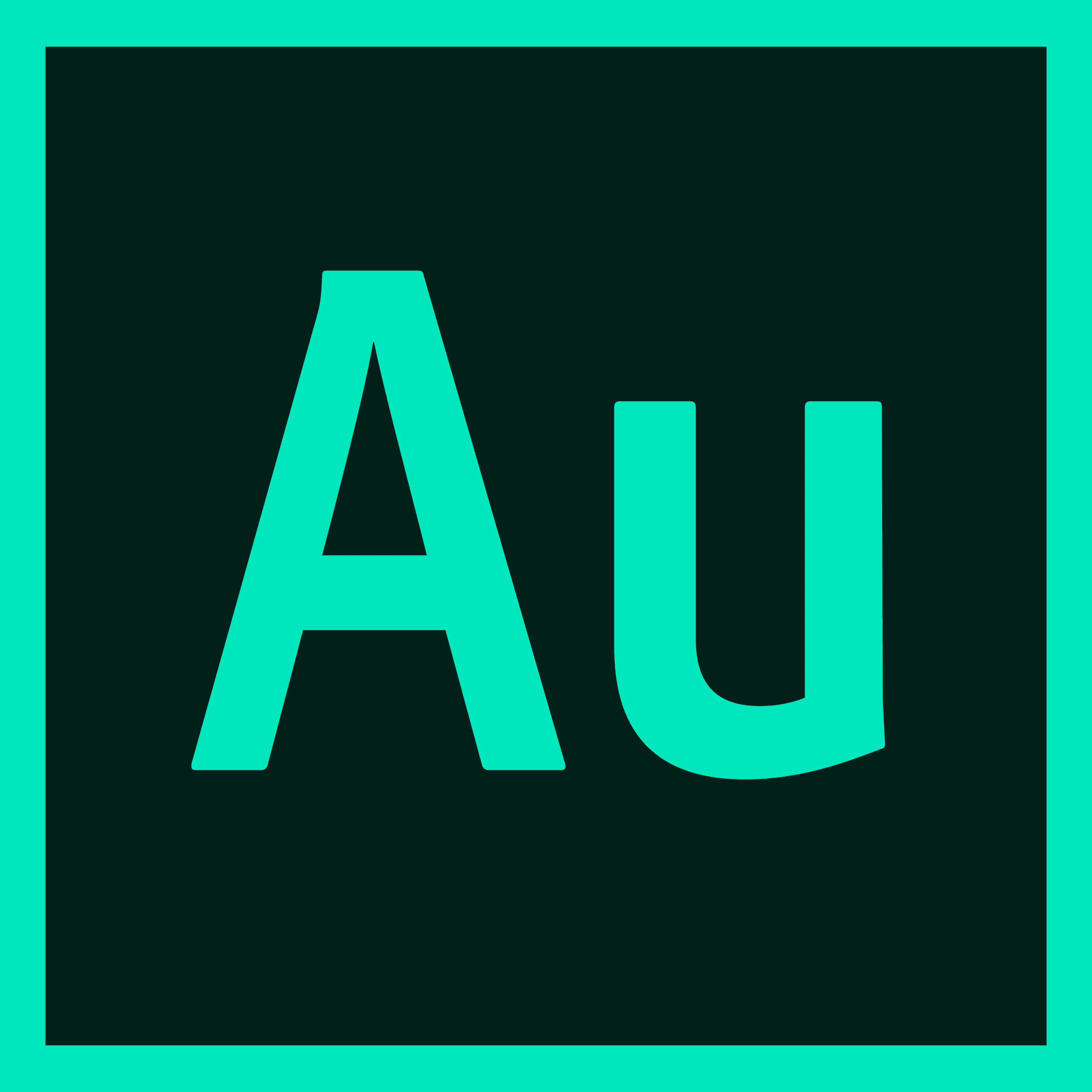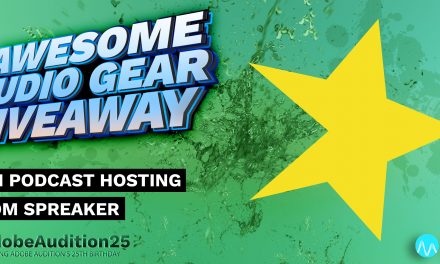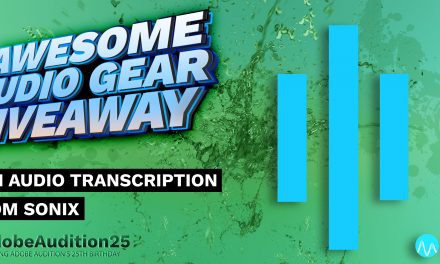Subscribe to the Adobe Audition Podcast
Never miss another episode of the podcast for Adobe Audition users by Adobe Audition users!
Adobe Audition Podcast – Durin Gleaves
: Hey I’m Mike Russell from Music Radio Creative and welcome to the Adobe Audition podcast honoring 25 years of Adobe Audition. In this series of twenty five episodes. I will interview power users of this awesome audio editing software we’ll reminisce back to the Cool Edit Pro days through to the introduction of multi-track editing and bring you right up to date with Adobe Audition CC and features like the Essential Sound panel. This show is brought to you by the awesome audio gear giveaway if you’d like the chance to win my perfect audio creator studio setup. Head over to MRC dot fm slash win and enter now. There will be mini prize draws every month with a final gear give away taking place at the end of September. That’s MRC dot fm slash W I N for a chance to win. Good luck.
: My guest on the podcast today is the one and only the Product Manager for Audio at Adobe. Durin Gleaves who has been wearing headphones on the Adobe Audition team since 2004 a lot of history with that fantastic audio editor. His passion for audio go back to his early days of hacking CB radios and also eagerly listening for backwards messages in records of all genres. Maybe I’ll ask him about that later. Durin welcome to the show.
: Hey thanks Mike.
: It’s awesome to have you on. So first of all obviously outside of the development of the Adobe Audition app I’m curious to know how do you use Adobe Audition.
: Well you know actually that’s a good question. Last year about this time I realized that I hadn’t done a lot of actual usage in a while I’d really been just focused on the development and the features and all of that and I decided I needed to get get back into it. So I actually spent far more time than I expected last year doing a dialogue mix and the final mix as well as a theatrical surround mix and the Blu ray mix for a documentary that was produced here actually by folks who live just down the street from me and it was it was a pretty amazing experience you know. They were a full Adobe workflow on their side. I went in sort of evangelizing Audition for the workflow to begin with and then had the opportunity just take it over and do most of it myself. And you know it certainly helped me realize that you know maybe where here and there. There were some places we could do things better that we really hadn’t considered before but that in the end I was just blown away at really how capable and usable Audition was especially when working so closely with a Premiere Pro project and the editing team on that film.
: That’s brilliant and the audio video integration between Audition and Premiere is just getting tighter and tighter. So it’s good to hear you say that as somebody who is right there at the coalface creating the product but actually you enjoy using it yourself and you do indeed use it in projects and that’s fantastic to hear. My next question is related to audio production advice. I mean we hear advice from all corners on how to make audio sound great and best practices and great techniques. I still have a memory a couple of years ago when we caught up in Amsterdam and you were telling me about the noise reduction feature an Audition and I’d I’d been previously cranking that out really high and getting that kind of fishtank or echo effect. And you said to me oh just just run it a couple of times lightly or two or three times lightly over the audio and you’ll get a better result. So I remember that as being good advice to me on how to use in particular Adobe Audition but just good audio production advice and I’m curious if there’s any advice you’ve ever been given about audio or producing audio or of course using Audition that has been valuable to you?
: Yeah that’s a good question and I remember that conversation and I hope we get to have a couple more beers in Amsterdam again soon. In the meantime yeah with some of the best production advice I think that I’ve received and that I’ve tried to share is kind of generic it’s not specific to Audition but it’s really when working with effects that aren’t creative when not putting you know crazy delays and wild pitch bends you know those kind of radio imaging style warping and sound effects. And then there’s also a place where you don’t want people to know you’re changing the sound you want it to sound as good as it can but you don’t want it to sound processed you don’t want it to sound very effected. And so one of the best pieces of advice I’ve received and I like to share is when working with those kinds of tools compressors and EQs a real good trick is to adjust your settings until you start just start to notice the effect happening. And then just dial it back just a touch. And it keeps it sounding very natural very clean and and mix the effects and the change is very subtle but they don’t step they don’t start to step over each other and they don’t start to be so noticeable that they draw the listeners or the viewers attention away from the actual content in the actual project itself.
: That’s cool. I really like that and I’ve heard similar advice on dialing in EQ as well. The temptation is there just especially with the parametric equalizer. The wonderful graph with the dot points on it just dragged them all up really high until you get this really crisp and amazing sounding vocal. And I’ve had advice where if you’re going above one db alteration on any of those dots you probably need to start again.
: Yeah get a better recording actually and you know you know it’s great advice. I can’t say that I always follow it myself but it’s certainly something to aspire to.
: So you work with a big team based not only in the U.S. but all around the world creating the Adobe Audition that we know and love. And I’m curious what the most challenging project you’ve worked on possibly recently with the Audition team might be?
: You know the one that’s really kind of taken a lot of our focus and turned out to be a little bit more effort and work than I anticipated has been the approach that we’re taking to the interchange experience with Premiere Pro especially video editing in general when working doing an audio mix working alongside those video productions. You know the current workflows that are out there built around aaf and omf files. They’re several decades old and they were built around this. This idea of picture lock which is this mythical magical moment when a director or an editor looks at their video timeline says oh man this is perfect. I’m done I’m not going to change another thing. And there’s all this amazing amount of time for color and motion graphics and sounds to come in and do their work. It doesn’t happen there’s no such thing. Anybody in the production post-production world will tell you picture lock is a lie and so much time is spent conforming changes to the video timeline so that the audio production team isn’t redoing a whole bunch of work but it just adds up. And so we decided to try and tackle this by getting rid of this idea of interchange altogether. We want a life without interchange formats where there’s simply a project and Premiere Pro is the ideal application for editing the video for that project Audition is the ideal application for editing the audio and all the other Adobe applications do what they’re best suited for. And while it’s a great vision and it’s a great tagline for the team it turns out that it’s a lot of work. And so we’re you know we’re getting there in incremental steps but it’s certainly something I wish we were able to do more quickly. But I think we’re absolutely benefiting from taking a little slower getting that feedback at each each step along that way as we as we progress toward that vision.
: Absolutely. And it is a great project to work on. Just the fact that you can work with video and audio so tightly in Audition and at the time of this podcast going out the the latest version that’s been around for a couple of months now has some fantastically tight integrations with video and audio editing in particular. I’m a fan of the fact that you can now grab and drag an audio clip and watch in real time the video frames updating. So I just get fascinated and hypnotized by the fact that you can. You can drop a beat or insert a sound effect at the exact moment that something happens on screen and so easily so that definitely has to be one of my favorite features in the latest release so a nobel but fantastic project that you’re working on there along with obviously Premiere Pro as well. Now I’m wondering and if you’d like you can drop an exclusive. But is there one cool thing that you’d like to work on that you haven’t told anyone about yet?
: There’s two things I’m fascinated with right now. One is the strides that have been being made with algorithmically generated music or artificial intelligence music. I remember listening to some you know years ago and it just sounded like a computer made of a song. It wasn’t interesting there was nothing memorable about it. And then I dabbled in it myself as a little side project and realized that the reason there hasn’t been a lot of progress is because it’s really hard and just the last several years we’re seeing several companies that have just developed amazing algorithms to come up with music based on genre or mood or criteria or even look you know timing of the content that it’s going to be associated with. I think that that’s really an interesting avenue for where some of the audio creation technology is going and something else cool that like to work on that I haven’t told anybody yet which isn’t audio related is Adobe has this Character Animator software which is just live capture animation. I have such a crush on this application right now. I find myself doodling you know Durin animator on the back of my notebook. You know for school and different variations with hearts over the eyes it’s just kind of silly. It’s a lot of fun and I’m I’m really having a good time playing with it.
: And yeah I’ve had a play with Character Animator as well. I understand that’s been used by productions such as The Simpsons. Right?
: Yeah that’s right. The Simpsons that a live call in episode last year where Homer Simpson answered questions live previously a terrible strain on the animators’ wrist but with Character Animator made it significantly more accessible and easier. Yeah it shows up all over the place you see it on Disney Channel you see it on several others. Perhaps in the future.
: Instead of appearing on the screen when I do my little tutorial videos I could have an animated Mike Russell puppet demonstrating.
: We’re going to have cartoon Mike in the corner.
: That’s so cool. And just before I get to the next question going back to what you said about the algorithmically generated music and using AI to generate music that’s a really interesting topic and I’m seeing some of those sites too including I think Jukedeck is quite a popular one at the moment that’s trying to do that. My question to you on that would be do you think that AI or this kind of algorithmically generated musical audio will ever replace the creator or replace musical creativity. Do you think it’s possible to do that?
: I don’t think that there’s a case to be made that this is going to change music that we listen to because we you know we enjoy the music itself but there’s so much music that’s used to fill out content videos, corporate videos, commercials, online advertising that the music itself is supporting everything else the dialogue and narration what’s on the screen. And a lot of folks and a lot of productions now use stock music and they’ll use the same. You know you go to the same stock websites that everybody else goes to. They’ll download to find the song. And I think you know I tend to have an ear for this so I kind of here I’ll see videos and I’ll know oh some other company use this exact same song on their advertisement or their commercial or their podcast. And you know I get the feeling that while there may be hundreds of thousands of songs that you know there’s the same kind of handful that are probably used most often that can actually show up and maybe cause some brand confusion or in the case of Facebook or YouTube they may get flagged as a potential copyright violation if they haven’t been cleared before. So I see algorithmic music sitting in that space where you don’t just want a blank narration or a voice over with nothing supporting it. You know you want to flesh it out fill out that that soundscape but you don’t necessarily need something that has been labored over and you know composed in is this amazing result of this creative endeavor. You just need in those cases some music that fits the mood and the genre and the style that you’re going for. And I think that’s where a lot of the AI music organizations really kind of have their niche is being able to not necessarily replace but supplement stock music in creative music services for places where maybe the budget or the effort isn’t as necessary as it might be for for other projects.
: When you think back to your childhood obviously you’ve always had a passion for audio there. So what is your one memory around audio that makes you smile.
: You know I’ll tell you my first my earliest memory about audio was when I was really young my mom had a my mother had a tape recorder and would talk to me when I was very young and then when my sister was born and taking up some of that attention she was part of it as well but we’d sit around the tape recorder and just record at different very young ages. And a couple of years back I found that tape in a trunk at her house. And so I brought it home and I digitized it and put it on a CD and we all over Christmas we listened to it for the first time in probably 35 or more years. That was a lot of fun. And I remember even though I was really young I remember the first time sitting around that tape recorder in the living room with my mom doing that. So maybe that that may stick out as one of those nice little warm memories around audio that I can dredge up from my otherwise old dusty brain.
: That’s awesome. I mean that’s fantastic to hear because it just shows the progression of recording audio and how it started off with tape recorders and reel to reel machines and then splicing on reel to reel machines. And finally there was the the kind of singular waveform that you can edit. I still remember I think it might have been early Adobe Audition or late Cool Edit where you could start doing mix pastes. No I think I’m right in saying the multitrack came in Cool Edit Pro 2.0 is that when the multitrack was first?
: I think you are absolutely correct.
: Wow.
: Very good memory.
: And that was. That would have been the late 90s?
: Yeah that would have been the late 90s early 2000s. Maybe Adobe acquired Syntrillium in 2003. Cool Edit Pro 2.1 had just come out. So it’s probably probably very early 2000s.
: So looking at Adobe Audition right now and the plethora of features there are there for audio creators in general. If you had to single out one feature that’s your favorite feature in Adobe Audition what would it be?
: Back to the interview in a moment but if you want to in my perfect audio creator setup. Head over to MRC dot fm slash win.
: Just one?
: Yeah.
: Well then I’ll I’ll take advantage of this to say while I would love to talk about the spectral editing which I’ve had the most fun with. I think my favorite feature in the last couple of years has really been the remix feature where we can take any song and do an analysis and then recompose that to any other duration. I’ve had so much fun using that in ways that will never be appropriate for production. But you know imagine taking The Beatles White Album and making a version of that album that’s only 60 seconds long.
: Wow. So cool.
: You know sometimes it works sometimes it doesn’t but it’s a lot of fun to experiment with and it’s so flexible that you can really experiment very quickly and build upon successes and quickly hide your failures.
: That’s so true. Actually just before we got on the Internet to chat I was listening to Bohemian Rhapsody by Queen or that track would sound like if you made like a 45 a 30 second version using Audition remix?
: That’d be interesting it’s a very you know it’s sort of a very progressive rock type of song lots of changes lots of stylistic and tempo differences. You know when we were testing that feature when it was first being developed I was throwing a bunch of music at it the whole collection and I found that some of that some of that progressive rock era. You know the classics it does a terrible job with Rush anything by Rush a lot of the more interesting Led Zeppelin songs it didn’t do very well with. But you know who knows your mileage may vary I’ve thrown some some pretty difficult and dynamic classical pieces at it and had surprisingly good results shrinking you know 15 minute concerto down to 45 seconds or two minutes. So I’m always surprised at how well it does with material I think is going to be particularly challenging.
: Just for anyone listening right now who’s not familiar with Adobe Audition remix. What it will do is it will take a piece of music of a certain length so it could be a three minute piece of production music as we’ve been talking about earlier. But you need say 45 seconds for a video promo that you’re creating. You can use Adobe Audition remix to not time stretch not pitch shift or anything else but make splices in certain areas of the song which the I believe the algorithm detects is the correct place to splice the song and you can get a fully edited version of that production library music from say three minutes and 45 seconds or 30 seconds if you like 15 or two minutes whatever you want. Does that description do it justice would you say?
: Yeah I mean it does what it says it remixes a song to some other duration my favorite one of my favorite anecdotes if you’ve got a moment was when we were working on that. It happened to be Photoshop’s 25th anniversary at that time and Photoshop makes Photoshop kind of revenue. So they bought themselves to celebrate. They bought themselves a 60 second commercial during the Super Bowl and they had this beautiful commercial produced lots of beautiful graphics and being edited and very famous images that were done in Photoshop and the music behind it was Dream On by Aerosmith. And they sent it off. They had a professional audio engineer do the remix. You know it was probably several thousand dollars it took a couple of weeks to get done but we got it back and an absolutely fantastic remix. It was worth every penny. But I decided to see. You know I wonder how remix would fare in Audition how that new feature would fare. So I pulled out the Aerosmith CD from my collection because I have an Aerosmith CD and put it in the drive and I timed myself from the moment I ripped the song from the CD to the time I had a 60 second version sitting behind the video as it was edited and aired on the Super Bowl. It took me 45 seconds beginning to end. And arguably I had as good or a better remix come out as a result. Now remix was not aware of the lyrics or the fact that you know most of us go and if we sing at karaoke night we nail the first verse and then nobody knows the lyrics to the second verse. So it chose to go ahead and use the second verse in its remix instead of the first. But apart from that it was a fantastic edit and it could have potentially just dropped right into the commercial and most people wouldn’t have been any wiser.
: Can you go under the hood little with how remix is working what it’s looking for? So is it looking for beats or…
: Yeah it does it does several types of analyses so it looks at every beat in a song and it does a harmonic analysis. Timbral analysis a source separated spectral analysis a phase analysis etc. etc. I think it does seven or eight different analyses for each beat and it essentially makes a web a matrix of confidence between how well one beat can blend into the next beat for every beat in the song. So that’s when it’s done this analysis which generally takes five or six seconds for every minute of duration of the piece of music. Once it’s done at once it has this map in memory so that I can say you know I want a 60 second version of this song and it finds the route along those beats that fits the musical signature and the tempo that I’ve selected and comes closest to that time that I’ve requested with the highest level of confidence and then there’s some parameters you can say I want you know you can say I will take more and it’s you know smaller clips more edits along the way for a better result or no I’d like to keep everything you know a few edits as possible and just accept longer clips or maybe favor harmonic if it’s a choral piece or an orchestral piece I’m gonna want to favor harmonic transitions over more timbral transitions which might be better focused for you know a solo sax or a guitar a lead guitar piece or something like that. So it’s very fast once it’s done that analysis and it’s very flexible and finding you know being able to just quickly listen to variations and jump back and forth between different remixes and different variations on those mixes.
: So looking at work flow and time saving shortcuts in audition I really like the feature that’s come out in the latest version has been around a couple of months now where you can open a tracks window and show and hide different tracks in the multitrack when working on a huge multi-track session where you get a lot of different vocal tracks and different music tracks. Being able to preset those views is amazing has definitely changed the way that I work with audio recently. What would be your amazing work flow or timesaving shortcut that you could recommend for Adobe Audition?
: You know one of the things that I typically do when I first get a project is I will go through and color code my clips. I’ll select all the dialogue clips or even the dialogue clips that are associated with a particular actor or speaker. I’ll change those to one color I’ll change other clips to different colors and I’ll just separate my content visually by color. It makes it so much quicker when I want to select a certain piece of content or all the clips of a certain element of my mix and it really lets me work a lot faster visually than I would if I was getting in the general vicinity and listening to these clips and selecting them you know one by one based on having to listen to it it’s one place where that visual assistance is really helpful.
: I like that I really really like that. So color coding clips and maybe whole tracks as well depending on the content of the track?
: Absolutely. I mean a lot of the projects that we see especially ones that come from an NLE or a video editor will kind of have maybe some of the content the music might be on its own track and maybe a couple of sound effects will be on their own track. But when they’re bringing in clips that are associated with video they kind of just get put wherever they fit. So there’s not always a lot of organization around say dialogue and narration or voiceover clips and so I will usually spend some time separating those out to separate tracks so that individual speakers may be on their own track rather than merged with another another speaker or other random audio clips. It makes a little bit of work upfront but it makes it so much easier down the road.
: Love it. And Durin what are your go to resources or your favorite bits of audio gear. When you’re creating audio you selfish you got any recommendations there?
: I love my mobile my Zoom H4. I’ve had it for a long time. I can take that anywhere. Capture some amazing sounds some folks on the team. Well a couple of years back we were in New York doing some custom customer visits brought that down. We just captured some amazing sounds on the subway in Times Square just going around the city capturing those things so having that available you know it’s small enough you can just throw it in a bag and carried around with you and it just has amazing recording quality. So it really helps kind of get those those natural sounds and those those sounds you may not have been able to capture otherwise or find online if you were looking through through sample libraries. I really really enjoy. I really for my own personal use I tend to use the Audio Technica microphones for a lot of what I record myself. So the AT2020. I really love the quality. It’s inexpensive enough that you know I don’t worry about it if I throw it into a backpack. You know something happens then. I’m not losing one of these. You know 800 dollar 2000 dollar microphones.
: Is that the mic you’re recording on now?
: Right now I’m actually because I’m on the laptop so I’m just using a USB Samson USB microphone for this call.
: Okay. Is that the C01U?
: C01U yeah.
: Awesome so the Zoom H4 I’ve heard a lot of podcasters talking about that so it’s really good to hear you say that the Zoom H4 is a go to portable audio recorder. The AT2020 from Audio Technica as well. Anything else that you’d recommend?
: You know there’s the I got started and I still have some very large control surfaces mixing desks and consoles like that. But we’re seeing such we’re seeing those get so small and portable now companies like SoundCraft which is part of Harman and the control surface modules for mixing and having transport control that’s not on the keyboard or the mouse. They’re just so they’re so handy and they’re so small now that they don’t take a lot of desk space. It really makes a lot of sense to have those around if you come and see us at trade shows like NAB or IBC. You might have seen that we have. We typically have on the Audition workstation. The Pallete Gear which is the little modular it was a Kickstarter project little magnetic modular a completely user assignable buttons and faders and knobs and there’s so much fun because there are not a whole control surface they’re not this big piece of gear that can be intimidating. They are almost like arcade buttons and sliders and you can assign them to anything so if there’s certain things that you’re doing quite a lot maybe adjusting a clip volume for a selected clip and you get tired of going back and forth to to the properties menu and adjusting it with the mouse. You can actually just a sign that to this this knob and it’s always there it’s always ready. It’s application aware. So if you switch from Premiere to another application the commands and the functionality of those controls can change as you switch the applications in though they’ll return when you come back. So I really have a lot of fun with that as well.
: Yeah it’s brilliant Palette Gear so tactile so possible to easily make fades and switches and dial things in and from what I understand you can pretty much assign any piece of software to that kit. So I’m still waiting to see someone who who decides to play an arcade game and assign the keys and the switches to that would be quite interesting. Some great gear there. So finally to wrap up this been a great chat I’m curious what you would tell the next generations what would you tell a young an aspiring audio producer who would like to get into the industry?
: You know I hope it’s not too profound to say just go do stuff go start. You know you don’t have to be creating things you don’t have to go to school and be working on a project to just go make sound and make a video and make things. I think that most of the people I know that’s how they got their start. It wasn’t that they went to school and learn the trade and just did it. They were inspired to go make a video or go record themselves or start recording music whether they hadn’t the skill or not. You know they were able to learn that on along the way. And I think that that’s maybe it’s you know it’s old advice but it’s I think it still holds true and it’s still about the most valuable piece of advice anybody can give is just go do it.
: That’s brilliant advice. I love it. Just start. Just get started and learn along the way and Audition makes that super easy as well. I mean remembering back to using it from the early days. It’s an intuitive piece of software and as an audio person I never fail to be impressed by the kinds of things that you can create inside a piece of software like Audition. It’s just it’s stunning and I never think you know everything. So I always think there’s something else to learn or another technique to learn and there’s so much you can learn from others so brilliant brilliant chat really really exciting to hear about everything that’s been happening recently with the Audition team. I really look forward to what is to come in the future as well. It’s fantastic to be celebrating 25 years now. I just wonder where we’ll be twenty five more years from now with Audition and with audio creation in general but Durin it’s been an absolute pleasure. Durin Gleaves the product manager for audio at Adobe thanks for joining me and if anyone was interested where could they find you online?
: You can always reach me at on Twitter @DurinGleaves or via our corporate @AdobeCCVideo I’m also on the Audition forums all the time and honestly I’m not that difficult to find. Google my name. There’s not too many of me out there.
: Awesome, Druin thanks for joining me on the show.
: Absolutely. Thanks so much Mike. This has been great.
: That concludes this episode would you like an extra chance to win the awesome audio gear giveaway. Hit subscribe and review this podcast then email the details to podcast at MRC dot fm for an extra entry into the awesome audio giveaway. Good luck.
